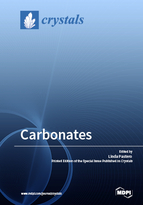Carbonates
A special issue of Crystals (ISSN 2073-4352). This special issue belongs to the section "Mineralogical Crystallography and Biomineralization".
Deadline for manuscript submissions: closed (15 June 2018) | Viewed by 58007
Special Issue Editor
Interests: crystal growth; epitaxy; surface; interface; calcite; gypsum; apatite; zeolite
Special Issues, Collections and Topics in MDPI journals
Special Issue Information
Dear Colleagues,
Even though the study of the minerals belonging to the group of carbonates is a longstanding and sound out topic, its relevance remains unchanged, due to the countless implications for a wide range of disciplines, from mineralogy and geology to biology, medicine, and industry. Moreover, the study of the interactions between carbonates and other minerals, such as phosphates, or between carbonates and organics, may disclose new opportunities for understanding the mechanisms involved in natural phenomena, such as biomineralization.
The goal of this Special Issue on Carbonates is to provide a comprehensive overview about both the state-of-the-art and recent advances in crystal growth and characterization of carbonate phases, pointing out the mechanisms of growth, the interactions among phases, and the applications.
Scientists working in a wide range of disciplines are invited to contribute to this Special Issue.
The topics may include, but are not limited to, the following:
-
Natural and synthetic carbonates
-
Crystal growth of carbonates
-
Epitaxial relationships
-
Twinning
-
Bioinspired/biomimetic materials
-
Inorganic/organic self-organized materials (nacreous-like materials)
-
Inorganic complex systems (such as carbonate/phosphate for example)
-
Applications
The first round submission deadline: 30 November 2017
Dr. Linda Pastero
Guest Editor
Manuscript Submission Information
Manuscripts should be submitted online at www.mdpi.com by registering and logging in to this website. Once you are registered, click here to go to the submission form. Manuscripts can be submitted until the deadline. All submissions that pass pre-check are peer-reviewed. Accepted papers will be published continuously in the journal (as soon as accepted) and will be listed together on the special issue website. Research articles, review articles as well as short communications are invited. For planned papers, a title and short abstract (about 100 words) can be sent to the Editorial Office for announcement on this website.
Submitted manuscripts should not have been published previously, nor be under consideration for publication elsewhere (except conference proceedings papers). All manuscripts are thoroughly refereed through a single-blind peer-review process. A guide for authors and other relevant information for submission of manuscripts is available on the Instructions for Authors page. Crystals is an international peer-reviewed open access monthly journal published by MDPI.
Please visit the Instructions for Authors page before submitting a manuscript. The Article Processing Charge (APC) for publication in this open access journal is 2600 CHF (Swiss Francs). Submitted papers should be well formatted and use good English. Authors may use MDPI's English editing service prior to publication or during author revisions.
Keywords
-
carbonates
-
crystal growth
-
epitaxy
-
self-organized materials
-
bio-mineralogy
-
bio-inspired materials
-
bio-mimetic materials
-
environmental mineralogy
Related Special Issue
- Carbonates Volume II in Crystals (5 articles)






